A Modern Economy Depends on Child Care. South Dakota Can Make It Affordable and Accessible.
December 2021
Child care is a critical component of a modern and thriving economy. High-quality and affordable care is essential for parents to stay in the workforce. Businesses across all sectors need workers who have a safe and reliable place for their children during the day. The coronavirus pandemic highlighted how important child care is and the complex challenges the system faces across the country. Child care businesses operate on narrow profit margins, struggle to pay adequate wages, and have high staff turnover. However, this long undervalued industry played a key role in reopening, allowing businesses to recruit and retain workers.
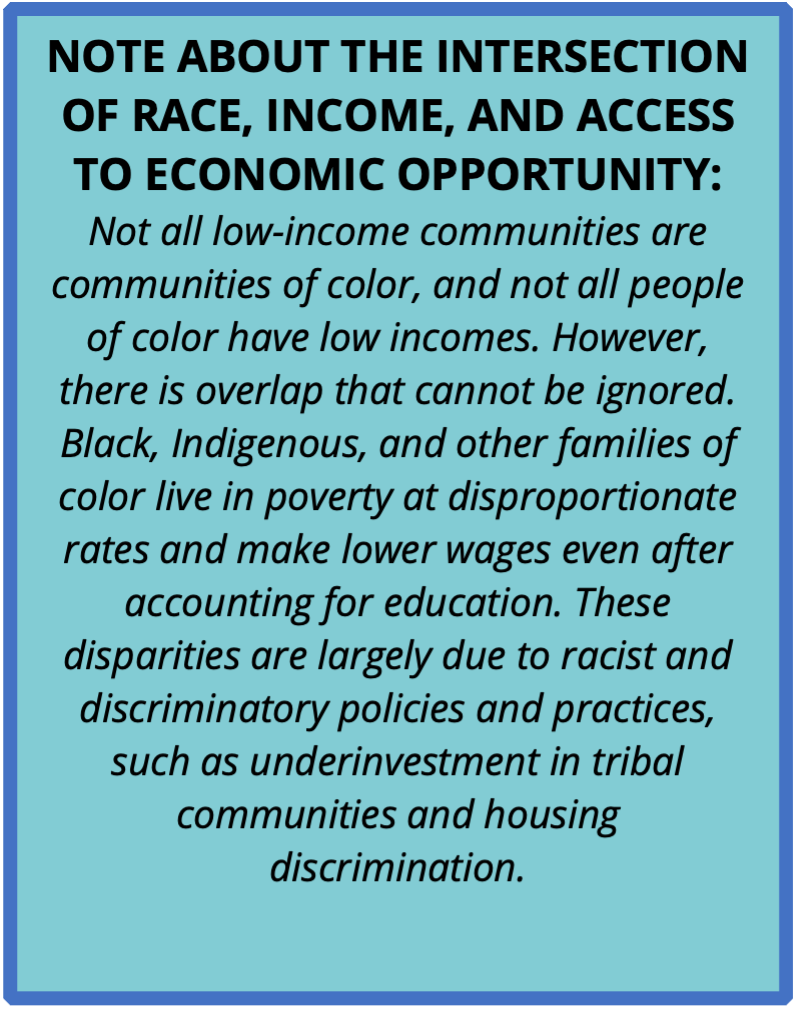
Solutions for improving the current child care system in South Dakota must consider addressing affordability and access for families of color. Many families in South Dakota struggle to find and afford child care. Child care makes up between 8 percent and 13 percent of a typical South Dakota family’s income.1,2 In South Dakota, Black, American Indian, Latinx and other families of color earn a lower median income due to generations of denied access to economic opportunity.3 The cost of child care is even further out of reach for families that earn less. For example, the federal government has failed to honor its trust and treaty obligations to provide health care, education, housing, and economic development in tribal communities.4 As a result, American Indian families in South Dakota today experience disparities in poverty rates and income inequality. Historic discrimination against families of color in areas such as housing has also had a lasting legacy on wealth generation and access to economic opportunity.5 When child care is even further out of reach for Black, American Indian, Latinx, and other families of color, it perpetuates the cycle of limited access to economic opportunity and education. Parents who cannot access child care miss out on advancing education, entering the workforce, and other activities that financially benefit families. Children also miss out on the opportunity to attend high-quality, early education.
A better child care system is possible in South Dakota. Policymakers should focus on long-term solutions and address the needs of families and child care businesses. This report provides an analysis of the state of child care in South Dakota and offers the following recommendations to improve access to affordable, quality child care:

Access: Child Care Is Limited in Many Communities Across South Dakota
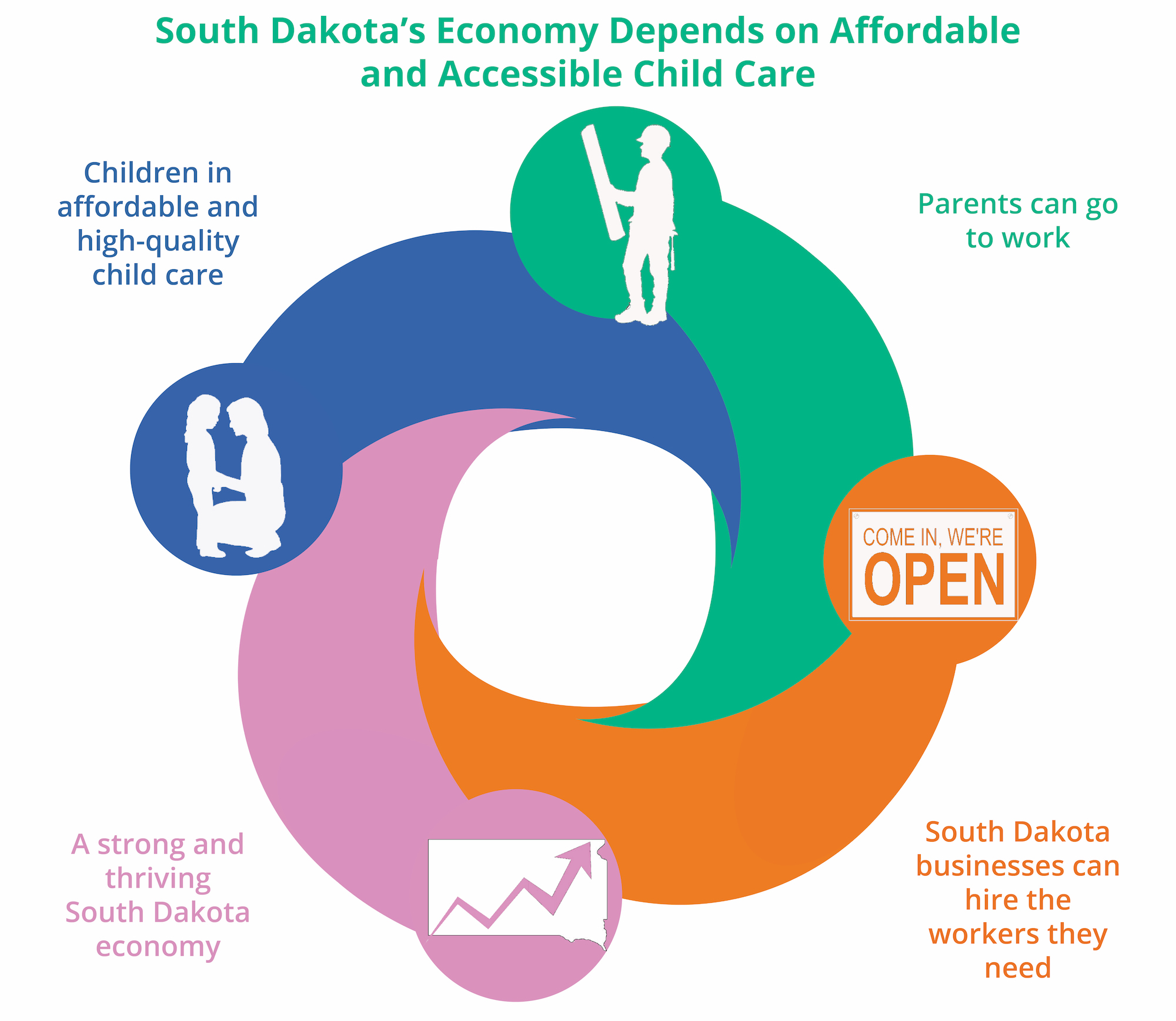
Nearly 73,000 children younger than age 6 call South Dakota home, and 74 percent of these children have all parents in the workforce.6,7 In South Dakota, child care programs are regulated if 13 or more children attend. Child care programs located in family homes with 12 or fewer children can voluntarily register with the state but are not required to be regulated.8 Compared to neighboring states, South Dakota’s requirements for child care regulation are lenient, allowing twice as many children as the next highest neighbor.9 Child care regulations ensure a provider meets health and safety standards. Lenient regulations in South Dakota mean children are more likely to be in unsafe environments. Unregulated family homes can still provide safe and high-quality care, however decisions about safety and well-being of young children are left to each provider rather than best practices. Some cities in South Dakota do require family child care providers to register or follow stricter city regulations.10
In 2020, South Dakota had an estimated supply of child care and early education slots for 34,540 children. The majority of child care slots come from licensed centers or family homes (25,353). Additional capacity comes from child care homes that voluntarily registered with the state (4,441) and Head Start or Early Head Start programs (4,746).11,12 While school-age children may attend licensed or registered child care programs, South Dakota has an additional 145 licensed before- or afterschool programs with 18,998 slots for school-age children.13,14
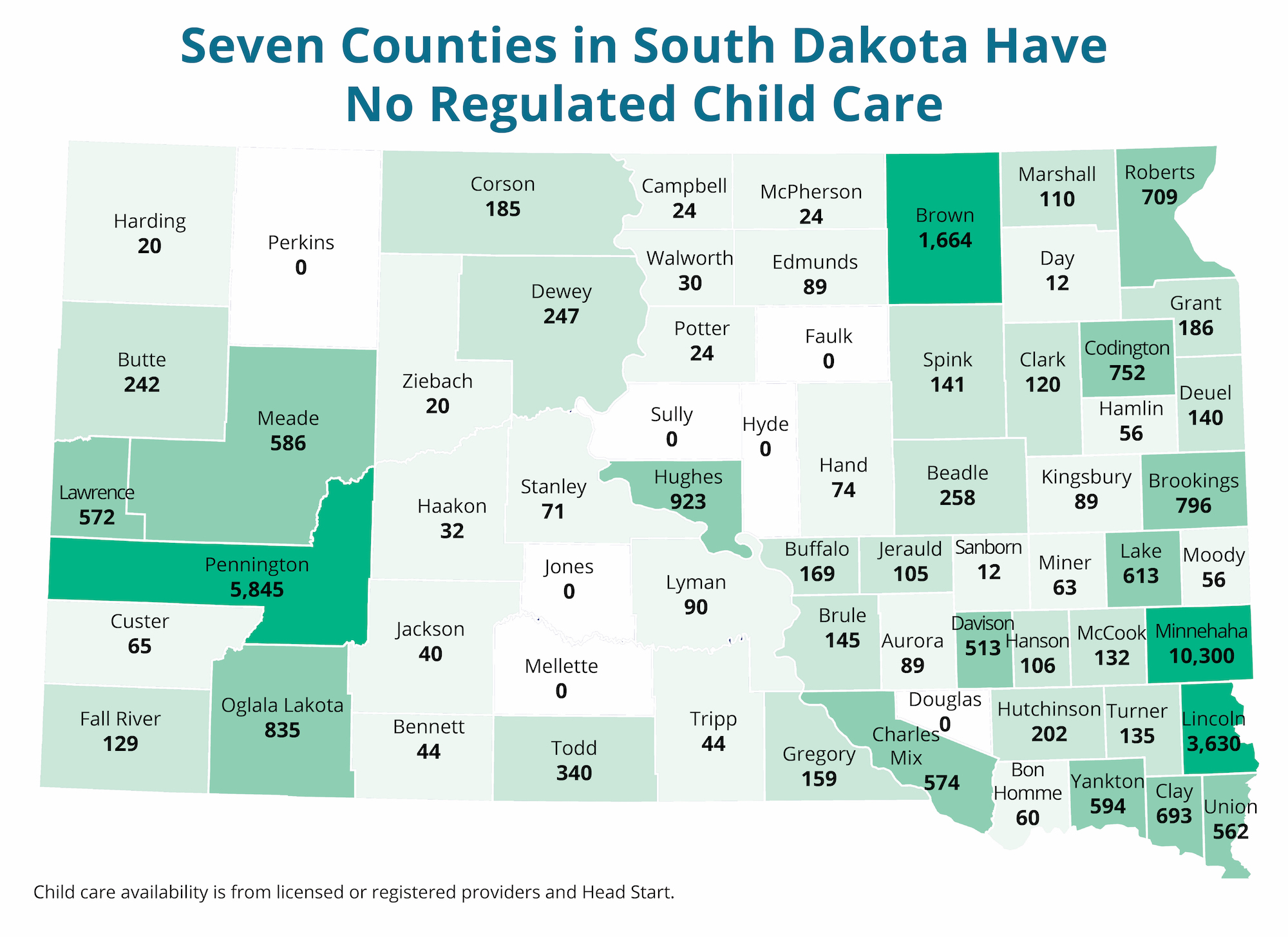
In the past decade, registered family homes have seen a drastic decline in available capacity, with half as many available slots today as in 2012.11 Licensed and registered family homes provide critical access to child care in rural communities that may not have enough demand to open a larger child care center. Because registration is voluntary, it is impossible to know if the decline in registered family homes is because fewer registered family homes exist or fewer have chosen to register.
Without better data on child care availability in family homes with less than 13 children, it is difficult to accurately assess whether the current availability of child care is adequate for the demand. Using available data, the licensed or registered child care and early education supply meets 64 percent of demand.15 This translates to a shortage of about 19,000 slots needed to meet the demand for working families. Seven counties (Douglas, Faulk, Hyde, Jones, Mellette, Perkins, Sully) have no licensed or registered child care facilities or Head Start sites even though there are working families with young children in those counties.11,12
Sioux Falls requires registration for all child care programs resulting in more complete data for child care availability. Sioux Falls is estimated to meet 85 percent of the child care demand, still falling short by about 2,000 slots.16 A survey in Brookings found that 36 percent of families were using unregistered family child care, and 12 percent were using a family or friend, leaving about half of the child care slots not captured in the statewide data.17 After adding in the additional, unaccounted-for slots, the child care supply in Brookings likely meets closer to 90 percent of the demand for working families.18 Despite meeting an estimated 90 percent of demand, families in Brookings report a disconnect between their current child care arrangement and preferred arrangement. The most commonly reported type of child care was an unregistered family home, yet only 3 percent said this was their preferred arrangement.17 While Brookings falls just short of the estimated child care demand, a more important question may be whether the current supply of child care reflects families’ needs and preferences. Many families also desire high-quality care for their children, where young children are in environments that support their social and emotional development and are cared for by trained early childhood educators. South Dakota does not currently have quality ratings for regulated child care. A standard rating scale to assess quality will help South Dakota families identify high-quality child care.
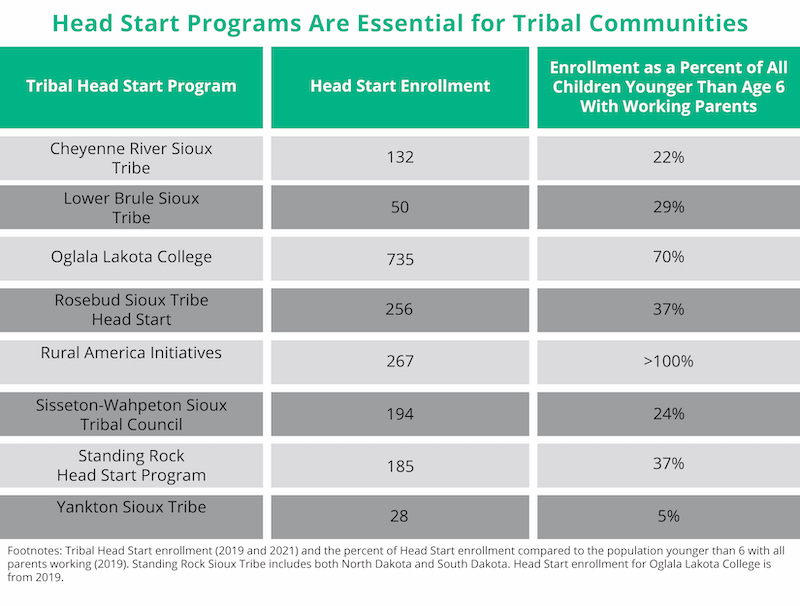
Ensuring access to child care and early education is critical for Black, American Indian, Latinx, and other children of color. Head Start and Early Head Start are important programs that provide evidence-based care and early education for diverse families across South Dakota. Children of color make up the majority of Head Start enrollment (67 percent compared to 29 percent of the child population in South Dakota), underscoring the importance of Head Start for communities of color.19,20 Eight tribal nations within South Dakota operate tribal Head Start programs and collectively enroll 1,847 children.12 On average, tribal Head Start programs provide care for 41 percent of children younger than age 6 with all parents working who live on one of the American Indian reservations within South Dakota.21 Not all families that are eligible for Head Start can attend. Estimates show that 70 percent of eligible children age 3 to 5 had access to Head Start and only 15 percent of eligible children age 0 to 2 had access to Early Head Start.22 Increasing access to Head Start is one solution to ensuring families of color have access to quality care and early education.
Parents of children with disabilities have a harder time finding child care that meets their needs.23 More than a third of parents of children with a disability reported at least some difficulty finding child care compared to 25 percent of parents of children with no disability. Parents of children with a disability are often left to rely on a patchwork of options to find child care or must reduce their work hours to accommodate caring for their child. Parents of children with a disability are three times as likely to make a career sacrifice to care for their child.
Child care for school-age children before or after school also falls short of the estimated demand. For every child attending an afterschool program, two more children are waiting.24 Parents report that cost, lack of transportation, and limited availability of programs are the top barriers to finding out-of-school care. The majority (81 percent) of parents with a child in an afterschool program say it helps them keep their job or work more hours.24 Expanding school-age care also provides an opportunity to support the state’s future workforce. Afterschool and summer programs help students gain skills and learn about new interests or professions.25
In communities without enough child care, parents must make difficult decisions about how or if to return to work. Career sacrifices that parents make to accommodate child care disproportionately affect women, particularly Black, Indigenous, and other women of color. Mothers of young children in South Dakota are less likely to be in the workforce, with 23 percent of females with children younger than 5 not in the workforce compared to 4 percent of males.26 Black (31 percent) and American Indian (51 percent) mothers are pushed out of the workforce at higher rates.26 When women, particularly women of color, are disproportionately left out of the workforce, they miss out on their own economic opportunities through further education or advancing in their own career. To improve access to child care and build a strong workforce, solutions must take into consideration the disparate impact the lack of child care has on women, particularly women of color.
Affordability: Parents Often Cannot Afford Child Care, and Child Care Businesses Struggle to Stay Open
South Dakota families struggle to afford child care. The cost for full-time child care varies based on age, the type of facility, and geographic location within South Dakota. Parents pay between $5,850 and $7,250 per year for an infant or toddler at a registered family home.2 It costs more for an infant or toddler to attend a licensed facility where parents pay between $7,020 and $9,830 per year.2 This means child care is as expensive as college tuition for some families.27
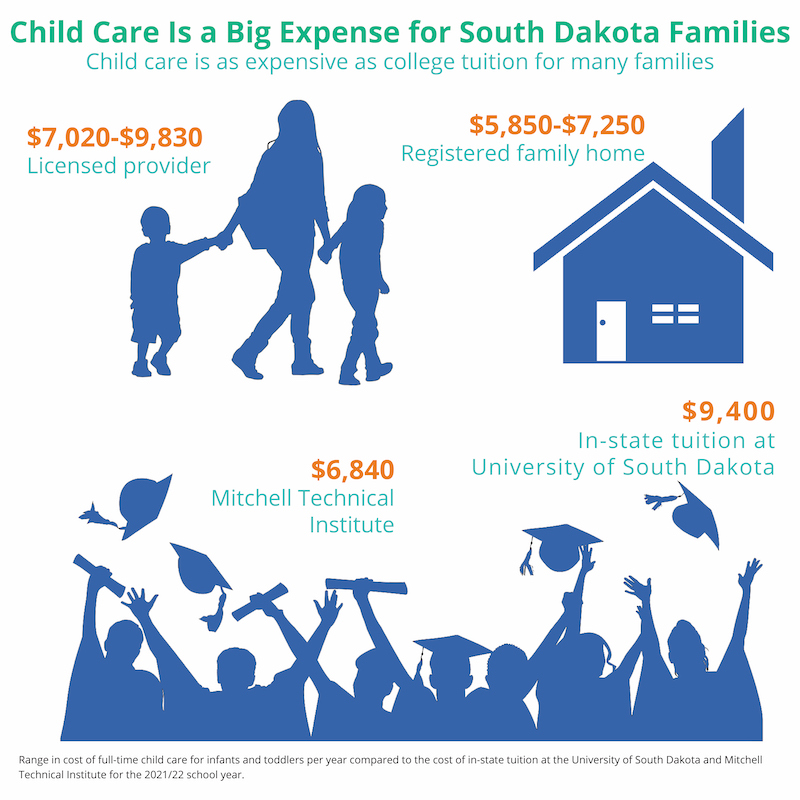
Access to affordable child care is a racial and economic justice issue. Child care is out of reach for many families in South Dakota but is disproportionately more unaffordable for Black, American Indian, Latinx and other families of color due to generations of denied access to economic opportunities. The lower-end cost estimate for infant or toddler care at a licensed child care facility ($7,020) makes up 9 percent of a typical family’s income.1,2 The cost of child care for American Indian (24 percent), Black (13 percent), Latinx (13 percent), and other (17 percent) families of color makes up a larger share of their income, putting child care further out of reach for these families.3 This means American Indian families must spend more than half their income on full-time child care and housing, leaving little to spend on other essentials like food, clothing, or health needs.28 When child care is further out of reach for families of color, it perpetuates the cycle of families of color having limited opportunities to work or continue their education.
The federal Child Care Assistance Program provides money toward child care costs for working families with lower incomes. The number of child care assistance recipients in South Dakota has declined consistently for a decade, dropping 41 percent between 2011 and 2021.29 More eligible children could benefit from the program than are currently participating. Estimates show that only one in 10 children younger than age 6 living below the income guideline received assistance.30,31 The Child Care Assistance Program covers the full cost of child care for families that live at or below 160 percent of the federal poverty level, or less than $35,140 for a family of three.32 Families with income above this level pay a co-payment. A family just below the income eligibility limit must pay a co-payment that makes up 12 percent of their income.
Child care businesses must balance the true cost of providing high-quality care with what parents can afford. Because of this, many child care businesses operate on narrow margins and often cannot pay employees an adequate wage. Low wages for child care workers leads to staffing instability, making it challenging for child care businesses to retain workers and remain open. In South Dakota, 3,830 individuals work in the early childhood field, about the same as the number of high school teachers.33 The median wage for South Dakota child care workers was $10.39 an hour in 2020, which translates to only $21,610 per year if working full-time.33 This is below the poverty level for a family of three.34 Child care workers make less than half the wage of a kindergarten teacher, even though 25 percent have a bachelor’s degree or higher.35,36 Recruiting a stable child care workforce is challenging with such low wages. Licensed providers report that 41 percent of full-time employees left their position in the previous 12 months.37 The child care workforce helps support businesses and the overall economy across the state, underscoring the importance of recruiting and retaining child care workers.
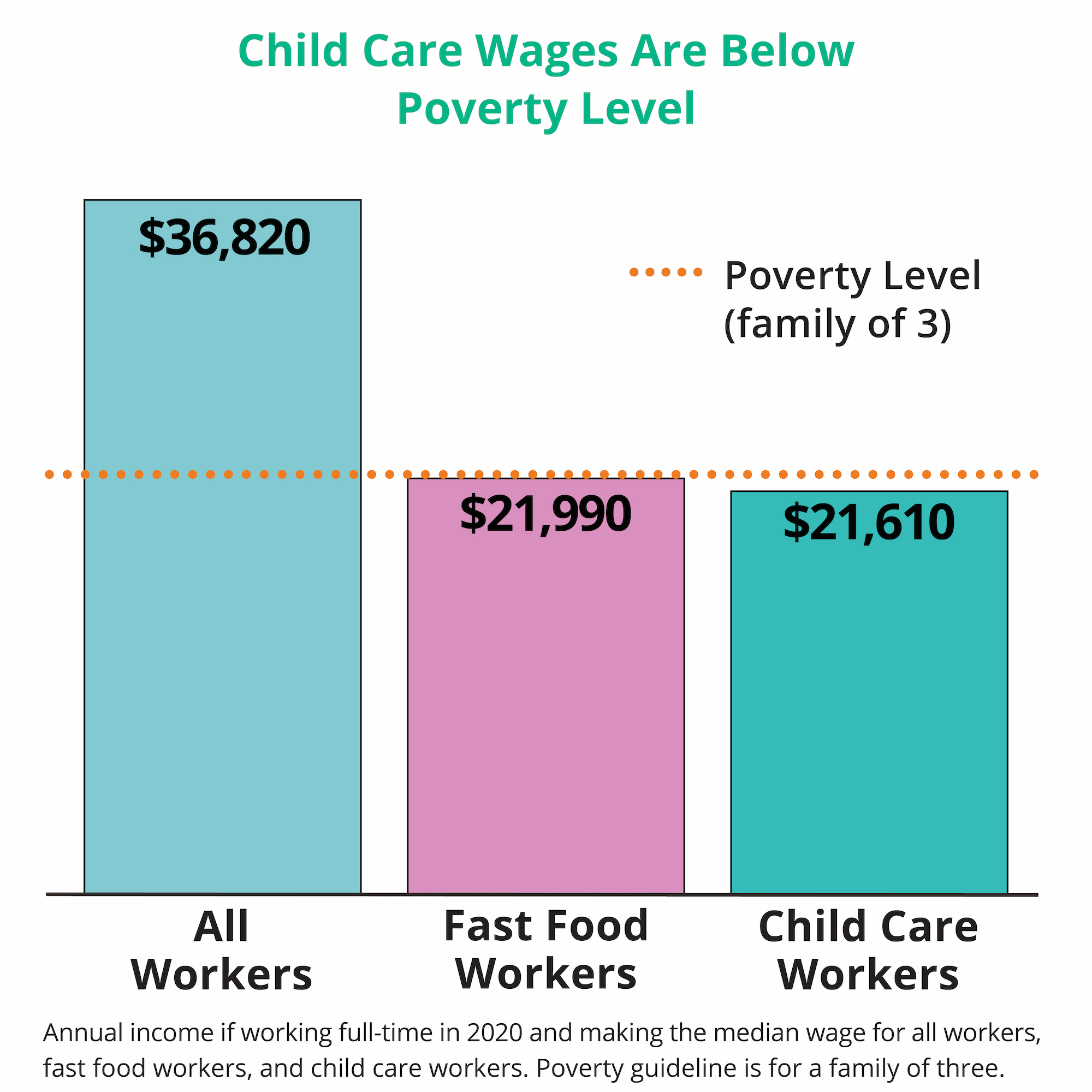
Poverty-level wages for child care workers disproportionately impact women, particularly American Indian women. Child care workers are more likely to be female (88 percent) and American Indian (11 percent) compared to all workers in South Dakota (47 percent female and 5 percent American Indian).36 Child care workers are essential and deserve wages that reflect the challenging work of caring for young children. Improving child care worker pay would also lessen the gender and race pay gap for women, particularly American Indian women, who make up a greater share of child care workers than the broader workforce.
Recommendations
South Dakota has minimal state investments in the child care and early childhood education system. Federal funding contributes 27 percent of the estimated cost to provide care to children younger than age 6 with all parents working, while parent payments or other private funds make up 71 percent.38,39 State investments make up only 2 percent of the estimated cost to provide care.40 A more stable and equitable early childhood education system is in reach for South Dakota. However, policymakers should prioritize investments in quality early childhood education to make that a reality.
South Dakota needs innovative, long-term solutions to build a better child care system that works for children, parents, and businesses. Specific recommendations include:
Access
- Update regulations so more programs are registered or licensed. Requiring regulation at a lower threshold of children would ensure recommended child care ratios and safety standards are met and facilitate better support for federal and state funding and interventions.
- Prioritize federal child care stabilization grants to areas with the most significant need. Areas of need include providers in communities that fall short of current demand, in areas with high concentrations of poverty or unemployment, and providers that serve children of color, children with special needs, and school-age children.
- Expand Head Start and Early Head Start slots, particularly in tribal communities operating tribal Head Start programs. Head Start is an evidence-based program and is essential for providing high-quality care in tribal communities. Head Start reaches only a fraction of eligible children. Investing additional funds in Head Start is a ready-built solution to reach more children in South Dakota.
- Provide grants to expand existing child care facilities or build new facilities. Grants should be prioritized in areas with limited access to care and at locations convenient for families.
- Encourage public/private partnerships. The state or communities can work with businesses that have room for child care to offer the space at low or no cost. When child care centers pay less on rent and utilities, they can pay higher wages or charge parents less for child care.
- Implement a quality rating and improvement program. A quality rating program can help increase the quality of care while helping inform parents as they make decisions for choosing child care.
Affordability
- Increase pay for child care workers and ensure professional development opportunities are available. Child care workers are essential and deserve wages that reflect the challenging work of caring for young children. Funding is needed to increase child care worker pay and/or provide bonuses to recruit a strong child care workforce. Funding for scholarship and apprenticeship programs for child care workers can ensure a skilled workforce.
- Reach more families eligible for child care assistance. Estimates show that only one in 10 eligible children receive child care assistance. An outreach campaign to eligible families would go a long way to help more families. Continuing to waive or lower the amount of co-payments can also help more parents afford child care. Ensuring that the child care assistance program reaches families of color can begin to address the limited access these families face due to generations of denied access to economic opportunities.
Footnotes
- Using the median household income for families in South Dakota, $76,826. U.S. Census Bureau, “Median Family Income in the Past 12 Months (In 2019 Inflation-Adjusted Dollars), 2019 American Community Survey 1-Year Estimates, Table S1903,” accessed on Oct. 21, 2021.
- Child care costs are estimated from the market rate survey and represent the cost at the 75th percentile. Market rates are reported in cost per hour and are calculated per year by multiplying nine hours of care per day times five days per week times 52 weeks per year. On average, full-time child care for children ranges from nine hours, four minutes on average at licensed facilities and nine hours, 32 minutes at registered facilities. A figure of nine hours was used for consistency across provider types. Child care costs ranges from $5,850 and $7,250 per year for an infant or toddler at a registered family home and $7,020 and $9,830 per year for an infant or toddler at a licensed center. Department of Social Services Division of Child Care Services, "South Dakota Child Care Workforce and Market Rate Report," Aug. 2019.
- Median family income by race is from tables B19113A-B19113I. U.S. Census Bureau, “Median Family Income in the Past 12 Months (In 2019 Inflation-Adjusted Dollars), 2019,” accessed on Oct. 21, 2021.
- U.S. Commission on Civil Rights, "Broken Promises: Continuing Federal Funding Shortfall for Native Americans," Dec. 2018.
- South Dakota State Historical Society, "Modern Residential Architecture in South Dakota, 1950-1975,” Aug. 2017, on file with author.
- KIDS COUNT Data Center, "Child population by single year of age," 2020.
- KIDS COUNT Data Center, "Children under age 6 with all available parents in the labor force," 2019.
- South Dakota Department of Social Services, "Licensing and Registration Information," accessed on Oct. 21, 2021.
- Iowa and North Dakota are the next highest neighbor for regulation requirements, where child care providers with six or more children are regulated by the state. Regulation requirements are from state agency websites, accessed on Oct. 6, 2021, on file with author.
- Communities include: Aberdeen, Belle Fourche, Sioux Falls, and Vermillion. South Dakota Association for the Education of Young Children, “Our children, our legacy then and now,” 2019, on file with author.
- KIDS COUNT Data Center, "Licensed or registered child care capacity," 2021.
- Office of Head Start, “Head Start Program Information Report,” 2019 and 2021, on file with author. Note: The Standing Rock Sioux Tribe overlaps with both North Dakota and South Dakota and both states are included in these numbers. Oglala Lakota College Tribal Head Start program did not have data reported in 2021 although the program is still operating. Data for 2019 was included for the Oglala Lakota College program.
- KIDS COUNT Data Center, "Licensed before and after school programs," 2021.
- KIDS COUNT Data Center, "Licensed before and after school program capacity," 2021.
- Includes slots that are licensed or registered with the state or are part of Head Start. A total for 34,540 slots compared to the estimated demand of 53,814. Demand is estimated as the population younger than age 6 (72,905) multiplied by the percent of children younger than age 6 with all parents working (74 percent). Supply as a percent of demand for working families is calculated using: Supply: State-licensed or registered capacity and Head Start Enrollment. Note: Head Start enrollment is matched to a county at the program level due to data availability. Some Head Start programs operate sites across multiple counties and data will not exactly reflect each Head Start site. Demand: Population Age 0-5 multiplied by percent of children with all available parents working: KIDS COUNT Data Center, "Children with all available parents in the labor force by age," 2015-2019.
- Olson, A., “Expensive and Inaccessible: Childcare in Sioux Falls, South Dakota,” Augustana Research Institute, Aug. 2021, on file with author.
- Brookings Economic Development Corporation, “Brookings County Child Care Survey,” May 2020.
- The survey found 48 percent of slots (36 percent from unregistered and 12 percent from family or friend) were not represented in the licensed/registration data or Head Start. Based on a demand of 1,883, there are an estimated 904 unaccounted slots. Adding this to the known supply of 796, there are a total of 1,700 child care slots, which meets 90 percent of the demand.
- Children of color include those identifying as American Indian or Alaska Native, Asian, Black or African American, Native Hawaiian or other Pacific Islander, Biracial/Multi-racial, other, or Hispanic. Data from: Office of Head Start, “Head Start Program Information Report,” 2021, on file with author.
- Estimates for racial demographics of child population age 0-5: Missouri Census Data Center, "Population Estimates by Age," 2020.
- Children needing care estimates (denominator of the percent) are from Census estimates at the American Indian Reservation geography. U.S. Census Bureau, “Age of Own Children Under 18 Years in Families and Subfamilies by Living Arrangements by Employment Status of Parents, American Community Survey 5-Year Estimates, Table B23008,” accessed on Oct. 21, 2021.
- National Head Start Association, "2021 South Dakota Head Start Profile."
- Novoa, C., "The Child Care Crisis Disproportionately Affects Children With Disabilities," Center for American Progress, Jan. 2020.
- Afterschool Alliance, "South Dakota After 3pm," Dec. 2020.
- Afterschool Alliance, “Building Workforce Skills in Afterschool,” Nov. 2017.
- Data represents responses pooled from 2016-2020 and includes adults ages 25 to 54. IPUMS-CPS, University of Minnesota, www.ipums.org.
- University of South Dakota, Estimated undergraduate tuition, fees and costs for 2021-22, accessed on Oct. 6, 2021. Mitchell Tech, Tuition & Fees, accessed on Oct. 21, 2021.
- The average cost of housing per year in South Dakota is $8,556. Economic Policy Institute, “The cost of child care in South Dakota,” accessed on Nov. 18, 2021.
- KIDS COUNT Data Center, “Child care assistance recipients in South Dakota,” 2011-2021.”
- Eligibility for Child Care Assistance is at 209 percent of the federal poverty level. Estimates from the Census are for less than 200 percent of the federal poverty level and are used as the closest cutoff, which means this number may underestimate the true eligibility. U.S. Census Bureau, “Age by Ratio of Income to Poverty Level in the Past 12 Months, American Community Survey 5-Year Estimates, Table B17024, 2015-2019,” accessed on Sep. 14, 2021. Population estimates are multiplied by poverty percentage. KIDS COUNT Data Center, "Child population by single year of age," 2020.
- Some families will be ineligible for assistance if at least one parent is not working, enrolled in an education program, or searching for a job. However, only 6 percent of children younger than 6 have no parents in the workforce, indicating the majority of income-eligible families are likely eligible.
- South Dakota Department of Social Services, “South Dakota 2021 Child Care Subsidy Co-Payments,” Mar. 2021.
- U.S. Bureau of Labor Statistics, Occupational Employment and Wage Statistics, "May 2020 State Occupational Employment and Wage Estimates South Dakota," accessed on Sep. 14, 2021.
- Office of the Assistant Secretary for Planning and Evaluation, “U.S. Federal Poverty Guidelines Used to Determine Financial Eligibility for Certain Federal Programs, 2021.”
- The equivalent hourly wage for kindergarten teachers was $24.71 in 2019 compared to $9.99 for a child care worker. Center for the Study of Child Care Employment, “Early Childhood Workforce Index 2020,” Feb. 2021.
- Center for Economic and Policy Research, “Characteristics of Workers in Frontline Industries – South Dakota, CEPR’s Analysis of American Community Survey, 2015-2019 5-Year Estimates,” Oct. 22, 2021, on file with author.
- Licensed group and center-based facilities reported that 674 out of 1,623 full-time employees left their position in the past 12 months. Department of Social Services Division of Child Care Services, "South Dakota Child Care Workforce and Market Rate Report," Aug. 2019.
- Federal estimates include: Child Care Development Fund (CCDF) both for the state and tribal nations located within South Dakota; Head Start/Early Head Start; Tribal Head Start/Early Head Start; Temporary Assistance for Needy Families (TANF) funds transferred to Child Care Assistance/Non-Assistance; Individuals with Disabilities Act Part C (Grants for Infants and Families) and Part B, Section 619 (Special Education for Preschool-Age Children). Total federal estimates are for $92.5 million. Exact amounts from each program are on file with author.
- The cost of care coming from parent payments or other private sources is subtracted for the estimated total cost of child care for the 26,519 0-2-year-old children with all parents working and 27,430 3-5-year-old children with all parents working. Using the average cost of care for these age groups, it is estimated that the total cost in South Dakota for the child care system is $347 million ($6,511*26,519 infants/toddlers=$172.7 million; $6,349*27,430 preschool-age=$174.1 million). Parents or other private sources are estimated to cover the gap of $247 million that is not covered by state or federal funding sources. Calculations are on file with author.
- State estimates include $7.4 million per year included in the General Fund to support the Child Care program. Estimated appropriation comes from: Department of Executive Management Bureau of Finance and Management, "State of South Dakota Budget in Brief Fiscal Year 2020."

